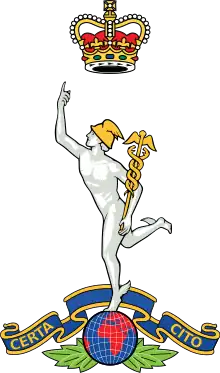39th (Skinners) Signal Regiment
39th (Skinners) Signal Regiment is an Army Reserve regiment in the Royal Corps of Signals in the British Army. The regiment forms part of 1 Signal Brigade, providing military communications for national operations. The Lynx badge is a reminder of the unit's connection with the Worshipful Company of Skinners.
| 39th (Skinners) Signal Regiment | |
|---|---|
 Cap badge of the Royal Corps of Signals | |
| Active | 1967 – present |
| Country | |
| Branch | |
| Type | Royal Corps of Signals |
| Size | Regiment of 385 personnel[1] |
| Part of | 1st Signal Brigade |
| RHQ location | Bristol |
| Nickname(s) | "The Skinners" |
| Reporting designation | 39 Sig Reg |
| Insignia | |
| Tactical Recognition Flash | |
History
The regiment was formed in 1967 by the amalgamation of 65th Signal Regiment and 92nd Signal Regiment, with some personnel from the disbanded Queen's Own Oxfordshire Hussars at Banbury.[2][3] In 1969 the regiment absorbed part of R (Tower Hamlets) Battery from the disbanded Greater London Regiment, Royal Artillery.[4]
In 1971 a new 5 (Banbury) Squadron was formed, which in 1975 became 5 (Queen's Own Oxfordshire Hussars) Signal Squadron.[2][5][6][7]
47 (Middlesex Yeomanry) Signal Squadron at Uxbridge formed part of the regiment from 1995 to 2006, when it transferred to 71st (City of London) Yeomanry Signal Regiment.[8][9]
In 2000, the North Somerset Yeomanry designation was revived for the Headquarters Squadron of 39th (Skinners) Signal Regiment[10] and, in 2008, that squadron, as 93 (North Somerset Yeomanry) Squadron, became the Regiment's Support Squadron.[11]
In 2006, 94 (Berkshire Yeomanry) Squadron transferred from 31st (City of London) Signal Regiment.[12]
In 2014, under Army 2020, 43 (Wessex and City & County of Bristol) Signal Squadron transferred from 21st Signal Regiment and 53 (Welsh) Signal Squadron transferred from 37th Signal Regiment, while 5 (QOOH) Squadron transferred to the Royal Logistic Corps.[13]
Current structure
The current structure of the regiment is as follows:[14][15]
- Regimental Headquarters, in Bristol
- 43 (Wessex and City & County of Bristol) Signal Squadron, in Bath
- 857 (City and County of Bristol) Signal Troop, in Bristol
- 53 (Wales and Western) Signal Squadron, in Cardiff
- Western Signal Troop, in Gloucester
- 93 (North Somerset Yeomanry) Support Squadron, in Bristol
- 94 (Berkshire Yeomanry) Signal Squadron, in Windsor
Honours
- Freedom of the City of Bristol in 2019.[16]
See also
Notes
- "Army – Question for Ministry of Defence". p. 1. Retrieved 14 December 2020.
- "39th (Skinners) Signal Regiment, Royal Corps of Signals". Regiments.org. Archived from the original on 27 February 2007. Retrieved 19 November 2017.
- Lord & Watson, p. 144–5.
- Frederick, p. 1042.
- QOOH at Regiments.org.
- 5 (QOOH) Signal Squadron (archive site).
- Lord & Watson, p. 148.
- Middlesex Yeomanry at Regiments.org.
- 1st CoLY at Stepping Forward London.
- "The North Somerset Yeomanry [UK]". Archived from the original on 15 July 2007. Retrieved 19 November 2017.
- "39 (Skinners) Signal Regiment". Ministry of Defence. Retrieved 29 October 2017.
- "The Berkshire Yeomanry (Hungerford) at regiments.org by T.F.Mills". Archived from the original on 15 July 2007. Retrieved 2014-03-28.
- "Summary of Army 2020 Reserves structure and basing changes" (PDF). Ministry of Defence. Archived from the original (PDF) on 1 December 2017. Retrieved 19 November 2017.
- "The Royal Corps of Signals Regimental Information". British Army. November 2019. Archived from the original on 11 July 2020. Retrieved 15 March 2021.
- "39 Signal Regiment". www.army.mod.uk. Retrieved 14 December 2021.
- "39 Signal Regiment exercise their Freedom of Bristol". Ministry of Defence. 24 February 2020. Retrieved 13 March 2020.
References
- J.B.M. Frederick, Lineage Book of British Land Forces 1660–1978, Vol II, Wakefield: Microform Academic, 1984, ISBN 1-85117-009-X.
- Cliff Lord & Graham Watson, Royal Corps of Signals: Unit Histories of the Corps (1920–2001) and its Antecedents, Solihull: Helion, 2003, ISBN 1-874622-92-2.
External links
- A Brief History of 39 (Skinners) Signal Regiment
- Land Forces of Britain, the Empire and Commonwealth – Regiments.org (archive site)
